Photo
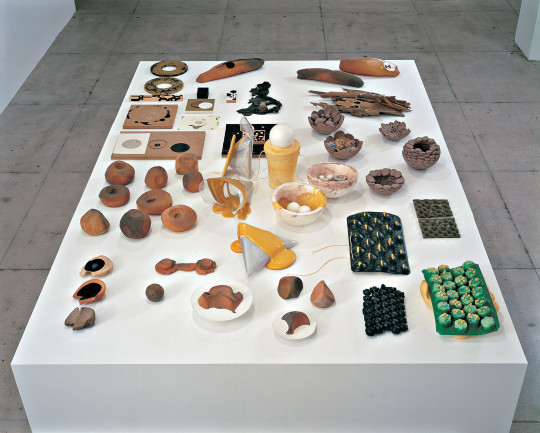
Gabriel Orozco, Working Tables, 2005
5 notes
·
View notes
Text
land art + andy goldsworthy
This past week was my first formal introduction to land art. In my mind, I immediately made a connection between land art and abstract art. Similar to abstract art, land art is not really interested in depicting a visual reality. It appropriates objects in different shapes, colors, and forms from the environment to achieve its effect, as well as the land itself. However, while these physical items and the landscape might be easily recognizable, their representation are obscured by their environmental context. Take for example, Andy Goldsworthy's impromptu piece accumulating found sticks into an embedded mass to create a hovering effect over a waterfall. While the material used for the piece was sticks, the artwork itself is not about the sticks but about the naturally occurring process of death and decay around the area. Although this connection between abstract and land art might be a bit of a stretch, it did help me to understand the latter better. In the end, I felt more drawn to the process of making land art than the actual art itself. For instance, Goldsworthy's process involved going on long walks and being open to the materials and conditions he found on that day. I thought that was pretty interesting for him to be so open about what he might encounter. Usually, when I think about art making, if I don't already have an idea, I brainstorm, look around the web, and sometimes sketch a bit, before I settle on something. But Goldsworthy embraces being in the moment and being receptive to the environment that is his canvas. I find that very fitting for the form of art he makes, but I also appreciated that there are some lessons that I could also take from that.
1 note
·
View note
Photo

Atul Bhalla, I Was Not Waving But Drowning II, 2005
#atul bhalla#I was not waving but drowning#water#religious aspects of water#political aspect of water#physical aspects of water#historical aspects of water
0 notes
Video
youtube
Suzanne Lacy, Three Weeks in May, 1977
2 notes
·
View notes
Text
socially engaged art + suzanne lacy
Between the Door and the Street was a filmed performance initiated by Suzanne Lacy in which hundreds of women gathered on the stoops along a residential block in Brooklyn and engaged in unscripted conversations about issues related to gender politics. Additionally, thousands of other people were invited to wander among the groups, listen to what they were saying, and form their own opinions. I was incredibly intrigued by this performance and half-way through the video, I began to wonder what others thought about it. But there was only a single comment underneath the YouTube post: "Has anything come of Suzanne Lacy's decree to establish women's self-defense classes at schools and government offices? Anything from a company that offers it or maybe a law or policy that got written?"
This response struck me not only because of the underlying tone of disappointment, but also because of the not-so-hidden accusation towards Lacy not meeting a certain expectation. This brought me back to the text by Helguera, in which he states: "...art students attracted to this form of art-making often find themselves wondering whether it would be more useful to abandon art altogether and instead become professional community organizers, activists, politicians, ethnographers, or sociologists." I think this YouTube comment shows that the uncomfortable position of socially engaged art is not only experienced by artists but also the public that interacts with their work.
I personally do not believe that Lacy's job as an artist encapsulates establishing women's self-defense classes at schools and government offices. I also question that even if that was her intention, if she has the political power as an artist to do such a thing. Of course her work can bring awareness, open discussions, and inspire movements, which ultimately leads toward positive community impact. However, in the end, the people that control the type of initiatives spoken by the commenter are elected officials and other community leaders, not artists. I think socially engaged art blurs the role and power of the artist. This can result in skewed perceptions of the artist's intentions and misreading of the authenticity of their work.
Helguera also talked about how "socially engaged art is specially at odds with the capitalist market infrastructure of the art world". This brought up these questions for me: what would it mean if Lacy did establish self-defense classes? What would the location and price of these classes reveal? The women-inclusive nature of Lacy's work is sure to clash with the money needed for this endeavor. Additionally, the locations that the classes would be available might play into racial and/or social economic disparities. I personally believe that this would negatively impact the authenticity of Lacy's artwork. Ultimately, I could not find any information about this decree that the user claimed Lacy had made. The closest thing I found was a piece by Lacy called Three Weeks in May, which focused on rape in Los Angeles. Lacy tracked rape occurrences during 21 days on a large map displayed on the L.A. City Mall and incorporated political speeches, radio interviews, news releases, art performances and self-defense demonstrations.
#suzanne lacy#pablo helguera#socially engaged art#three weeks in may#between the door and the street
3 notes
·
View notes
Video
youtube
0 notes
Photo
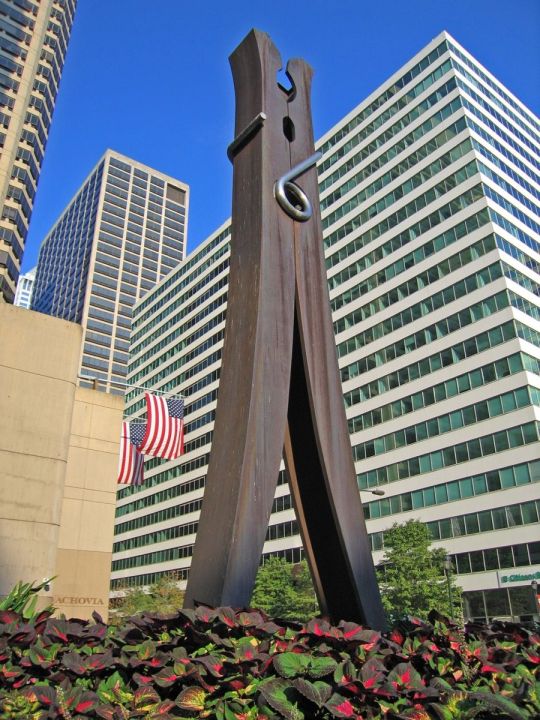
Claes Oldenburg, Clothespin, 1976
3 notes
·
View notes
Text
pop art and vernacular culture
While reading the excerpt from Pop Art and Vernacular Culture, I couldn't help but think back to the Manifesto of the Communist Party. Although the latter was a much earlier reading, some of the notions it expressed regarding the social conditions that formed our current global economy, were heavily connected to the rise and influence of pop art. Marxists believe that the colonization of the West resulted in a series of revolutionary components, which expeditiously changed our commerce, navigation, and industry. This led to the manufacturing system of production, which gave birth to the steam and machinery revolutionized industrial production. Consequently, this created the modern industry, leading to our current world market. Pop art heavily critiques this mass marketing practice and consumer/capitalist/vernacular culture that emerged, particularly after World War II. This is especially seen in the imitation of industrial printing techniques, such as Ben-Day dots, that pop artists use in the production of their work.
Among the many points and questions posed in the reading, the one that caught my eye was: "What exactly does pop art look like when viewed through a post colonial lens?" It is apparent to me that the effects of globalization on art has resulted in the hybridization of art forms. It has also brought up a question surrounding authenticity. Pop art, which is characterized by clearly rendered images of popular subject matter, such as graphic images and easily recognizable brand logos, calls to attention the artifice of mass-marketed commodities. In doing so, there is much emphasis on hidden authentic life, experiences, and individual identities.
#pop art#vernacular culture#manifesto of the communist party#global economy#brand logo#graphic images
0 notes
Photo

Nicole Awai, Reflection Pool, 2019.
1 note
·
View note
Video
youtube
0 notes
Text
style wars
Watching Style Wars made me appreciate graffiti art a bit more. As someone who did not grow up in the United States, I haven’t had much exposure to graffiti culture and the history of its origin. I honestly didn’t even know there was such a negative connotation with the art style, as expressed in the film. I am a local of Miami and I’ve had the pleasure to work in Wynwood, which is a district known for its many colorful murals. My time working in this district was the closest I’ve been to graffiti culture, but even then, I was mostly an uneducated spectator. I mainly connected with the murals that I would see on the wall because those were concrete images, which I could understand. I think I appreciated the colors of the graffiti, but found them hard to read/understand and sometimes, I was disturbed by the tagging of murals done by other artists. However, having watched Style Wars, I feel that I have a better understanding of art made on walls or other public spaces. Unlike in museums, where is singular ownership of art, public art such as a graffiti, has communal ownership. It changes overtime as other artists accept the invitation to make their mark, and sometimes completely disappears to make space for something new. After watching the film, I considered the origin of graffiti art. Although the people in the film did not really talk about this, I felt as thought it might have come about as a reaction to the stratification of art due to the iron grip museums and galleries have on determining what is considered art and more importantly, valuable art. I think in a society in which all art forms were regarded equally and the prestige of the museums weren't placed above the actual art themselves, graffiti would probably not exist. The style is so rebellious, so if there was nothing to rebel...I thought see how it would be possible. Alternatively, it could exist but in harmony, instead as a juxtaposition to "regular" art.
0 notes
Photo
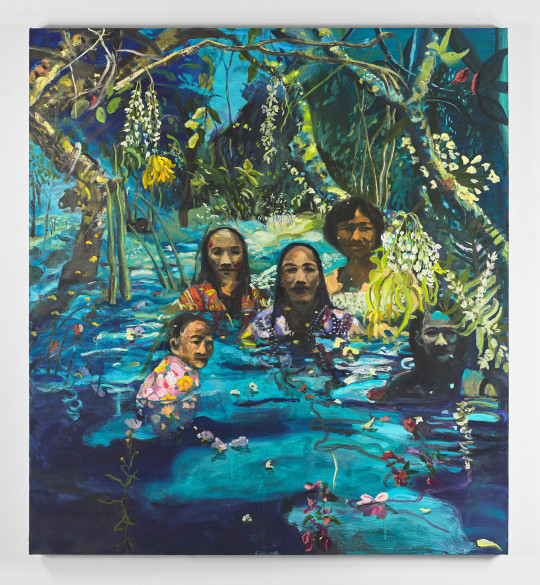
Maia Cruz Palileo, Wild Flowers, 2019
4 notes
·
View notes
Photo
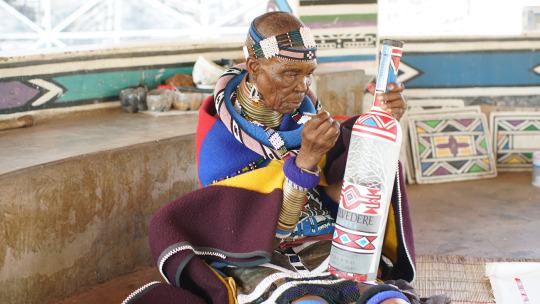
Esther Mahlangu
0 notes
Text
nicole awai + maia cruz palileo
Nicole Awai is an artist based in Brooklyn, New York and Austin, Texas. In her work, she explores Caribbean and American experiences and landscapes. Awai's unique style in overlaying images in her paintings, which produces shifting backgrounds and foregrounds, reminds me a bit of Maia Cruz Palileo's preliminary work for paintings. However, as a quick disclaimer, I was working on my 20x20s presentation on Palileo when Awai gave her lecture. So, there's a possibility that my over-exposure to Palileo's work during that time influenced this connection. Regardless, I think both artists are using similar tools to explore comparable subjects. For instance, for many of Palileo's paintings, she extracted figures from archives and photos to seamlessly bridge the historical fragments and the details from her family members' recollections. She was able to produce completely new images by merging these cutouts into a more accurate representation of her Filipino ancestry. While Awai does not work with cutouts, much of her work has a collage feel due to the overlaying of the pictures she creates. Additionally, Awai utilizes memory similarly to Palileo to explore her own identity politics in her art practice. Awai discusses the popular culture of the African diaspora, but some of her work also explore more personal narratives. Moreover, both of the artists' works have a dream-like quality. Palileo's technique in meshing memories with cutouts and her emphasize on color helps to achieve the dreamy characteristic of much of her work. In contrast, Awai does not use color to same extent and intensity that Palileo does. Yet, she is able to achieve the same fantasy-like characteristic through the overlay of pictures.
0 notes
Photo
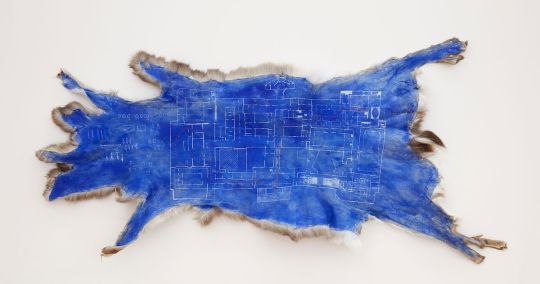
Nicholas Galanin, Architecture of return, escape (Metropolitan Museum of Art), 2020
78 notes
·
View notes
Photo

Nicholas Galanin works on the Wolf Totem Pole
0 notes